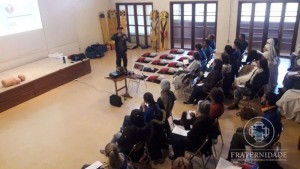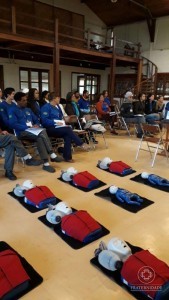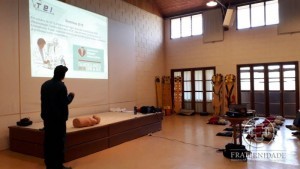More than 30 people who have the desire to help their fellow beings meet again this week for another period of basic training that a volunteer for humanitarian missions needs to have. This is the third consecutive month that this class gathers together to learn to deal with situations that are frequent in the missions organized by Fraternidade-International Humanitarian Missions, which has already done 22 in various countries and provides permanent assistance in some of those, such as Roraima (Brazil), where since 2016 it has administered five shelters that receive Venezuelan refugees.
The activities, which are carried out during one week each month, will again be in Carmo da Cachoeira, Minas Gerais (Brazil), a city where Fraternidade is headquartered, maintains a permanent mission with the same name as the municipality, and is intended for the needy population; it is normally the place for the periodic training of the volunteers that participate in its missions. This time, the team of students is doing a course on first aid, carried out by three teachers of TEI Soluções – Training Emergency Industrial, a company that specializes in this area, explains Imer, the coordinator of the training and one of the earliest missionaries of Fraternidade.
The partnership with TEI , founded more than 12 years ago, is important in this phase of the training of the missionaries, says Imer, once it is a company recognized in this type of training, qualifying the rescuers based on the working standards of the federal government, of ABNT – Brazilian Association of Technical Standards and on the international rules of the National Fire Protection Association and the European Regulation.
“This course includes all kinds of emergencies, be it about fires, rescue, or even chemical. For the missionaries, that are active in areas of conflict or with people that are fleeing conflicts, it is important because it has to do with the treatment of the wounded, from gunshot wounds, explosions, or caused by injury or illness. It is not only training focused on urban environments. It is more advanced: it is for attending to any kind of victim,” affirms Breno Botelho, one of the founding partners of TEI and a teacher in rescue and medical emergency, from combat to fires and search and rescue in remote areas for the last twenty years.
Practical, theoretic, and simulated classes
This formation of rescuers involves a theoretic content, but also practical and simulated classes – some will be done at night. According to Mariandja, also a coordinator and missionary of Fraternidade, the class will learn about bio-safety, bio-mechanics of the trauma, how to evaluate a patient that needs first aid, muscle-skeletal trauma, immobilization and transportation of people that need first aid, emergency childbirth, among other subjects related to the activity of a rescuer.
Imer observes that the team finishes this stage of the training, which in total has an average duration of 15 months, with a rescuer certificate in hand. Mariandja also reminds us that this learning is for life. “Even if the participant never goes out on a humanitarian mission, they will be able to deal one day with an emergency situation, applying this knowledge and saving lives. That is already helping a fellow being,” she affirms.
The humanitarian missions organized by Fraternidade are carried out by volunteers and financed by voluntary donations. If you wish to help your fellow being, the animal and environmental causes, participating in humanitarian missions, or if you wish to collaborate in some other way so that they may continue to carry aid to whomever needs it, send an email to secretaria@fraterinternacional.org









